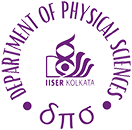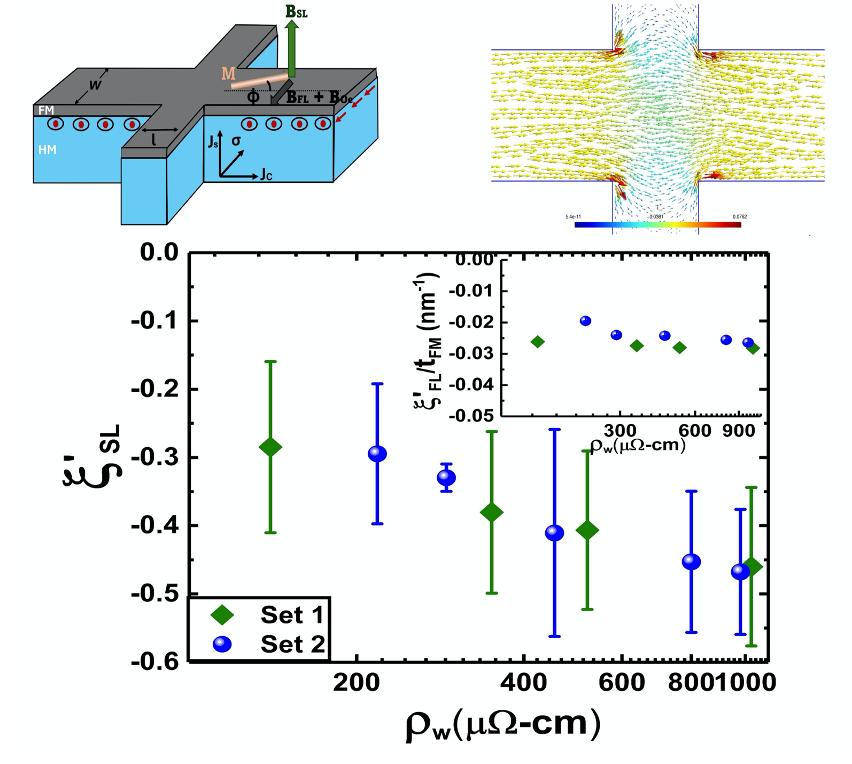
SPINTRONICS LAB: Decoupling of Spin-Orbit Torque Components in Py/W Bilayers unveiled through variation of W-resistivity
Harmonic Hall measurements were performed on a series of ferromagnetic metal/heavy metal (FM/HM) bilayers consisting of Permalloy as the FM and beta-Tungsten as the HM, and the efficiencies of the two orthogonal components of the spin-orbit torque were extracted. Two sets of Hall bar-shaped devices, differing in the aspect ratio of the voltage pickup line width and the current channel width, were studied. Within each set, the resistivity of the Tungsten layer was systematically varied over a wide range (approximately 150–1000 micro.Ohm.cm). To account for geometry-induced variations in current distribution, numerical simulations were performed, and a correction protocol was developed to normalize the torque efficiencies obtained from the conventional analysis. After applying the correction, the Slonczewski-like (anti-damping, in-plane) torque efficiency exhibited a consistent dependence on Tungsten resistivity across both device sets. In contrast, the field-like (out-of-plane) torque efficiency remained largely independent of Tungsten resistivity, reinforcing the notion of its interfacial origin.
Publication Details: Applied Physics Letters 127, 262404 (2025) , Abu Bakkar Miah, Harekrishna Bhunia, Dhananjaya Mahapatra, Soumik Aon, Partha Mitra
#Research Highlight
Posted on: January 3rd, 2026
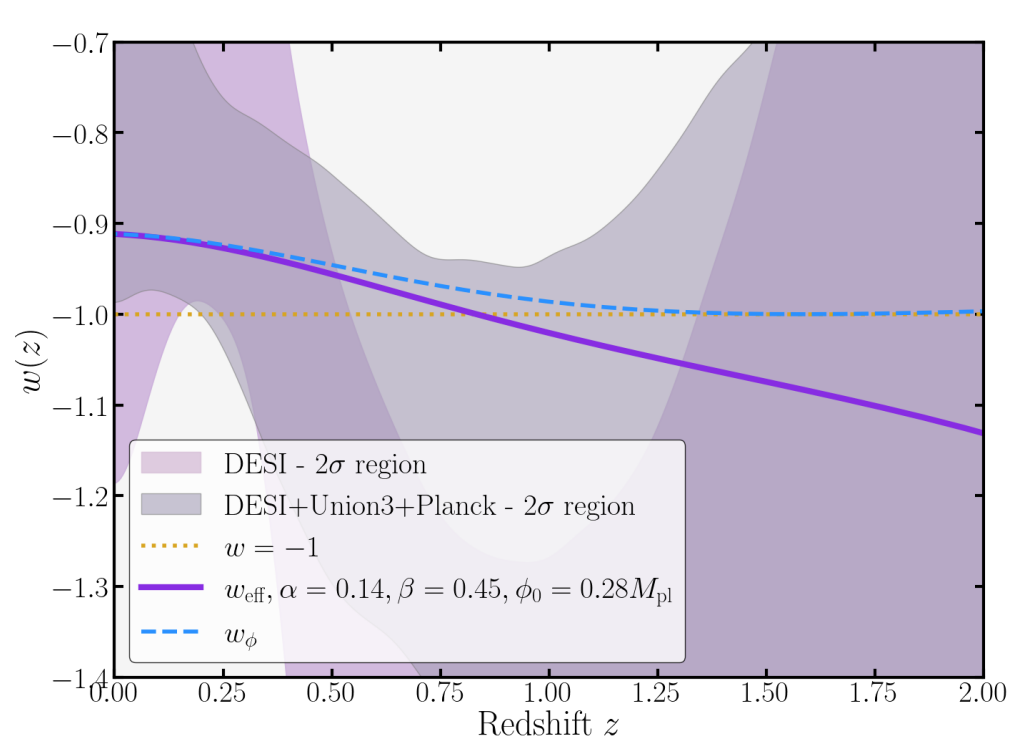
DESI: When the Dark Sector Speaks
Recent results from the Dark Energy Spectroscopic Instrument (DESI) have created excitement in the cosmology community by suggesting that dark energy may not be a constant after all. Instead, DESI’s measurements indicate that dark energy has evolved over time and even briefly behaved more repulsively than expected — a phenomenon known as “phantom crossing.”
Our recent work provides a natural and theoretically consistent explanation for this behaviour. We explored a scenario in which dark matter and dark energy interact with each other through a very gentle long-range force. This subtle interaction can make dark energy appear more repulsive in the past, exactly as DESI observes, without requiring any exotic or unstable physics. In our model, dark energy is described by an ordinary quintessence field with positive kinetic energy. However, because its energy is influenced by the behaviour of dark matter, the “effective” dark energy seen by observers naturally crosses the phantom line during cosmic evolution.
The model reproduces the pattern inferred by DESI: dark energy appears more strongly negative in the past and gradually approaches a milder value today. It also agrees well with combined data from DESI, Planck, and Type Ia supernova observations. This makes our approach one of the simplest and most robust explanations for DESI’s indication of evolving dark energy.
The results highlight the possibility that dark matter and dark energy — the two dominant but invisible components of the Universe — may not be independent, but instead quietly influence each other in a way that shapes cosmic history. Ongoing and future DESI data releases will allow us to test this idea further and explore whether interacting dark sectors hold the key to understanding the accelerated expansion of the Universe.
Journal Reference: Amlan Chakraborty, Prolay Chanda, Subinoy Das and Koushik Dutta; JCAP11(2025)047, https://arxiv.org/pdf/2503.10806
#Research Highlight
Posted on: November 14th, 2025
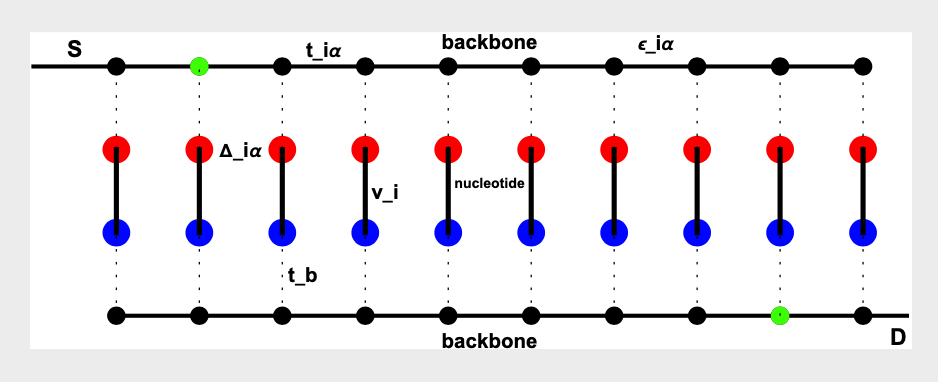
A new paradigm for charge transport in DNA
The work on "Backbone Mediated Electrical Transport in a Double-Stranded DNA" by Sourav Kundu and Siddhartha Lal got published in Physical Review E.
In the field of DNA nanotechnology, the prevailing understanding of charge transport in double- stranded DNA is that it occurs through pi-stacked nitrogen bases of the double helix. This has, however, been challenged in recent experiments by Zhuravel et. al. (Nat. Nanotech. 15, 836, 2020), suggesting instead that electronic transport obtains through the backbone channels. The striking experimental observation is that the presence of two local disconnections (labelled as “nicks” by the authors), one on either of the two backbones, causes the current passing through the DNA to vanish altogether.
To investigate this further, we studied the charge transport properties of three DNA sequences (periodic GC, periodic AT, and random ATGC) using a tight-binding model where backbones act as the main conduction channels. Our analysis, based on Green’s function method, focused on single- particle density of states and localization properties of DNA with nicks along the backbone channels. We also examined the impact of nicks on current-voltage response using the Landauer-Buttiker formalism in a two-terminal setup. Our results show that the periodic GC sequence exhibits metallic behaviour, while the periodic AT and random ATGC sequences are insulating. Interestingly, a single nick on the upper backbone of the periodic GC sequence has little effect on electronic transport, but adding a second nick on the lower backbone completely suppresses the current.
This behaviour is consistent regardless of nick positions or electrode arrangement. Analysis of the position-dependent probability distribution of the zero-energy electronic wave-function suggests that the insulation mechanism arises from a unique quantum interference of the electronic wave- function from the two nicks. Identical conclusions are obtained for the periodic AT and random ATGC sequences in their conducting regimes (obtained above a threshold voltage). In this way, our study opens the door towards further experimental and theoretical investigations of DNA nanotechnology that exploit the backbone conduction mechanism.
Journal Reference: Phys. Rev. E 112, 014401 (2025).
https://journals.aps.org/pre/abstract/10.1103/8xkb-rnzy
https://doi.org/10.1103/8xkb-rnzy
#Research Highlight
Posted on: August 29th, 2025
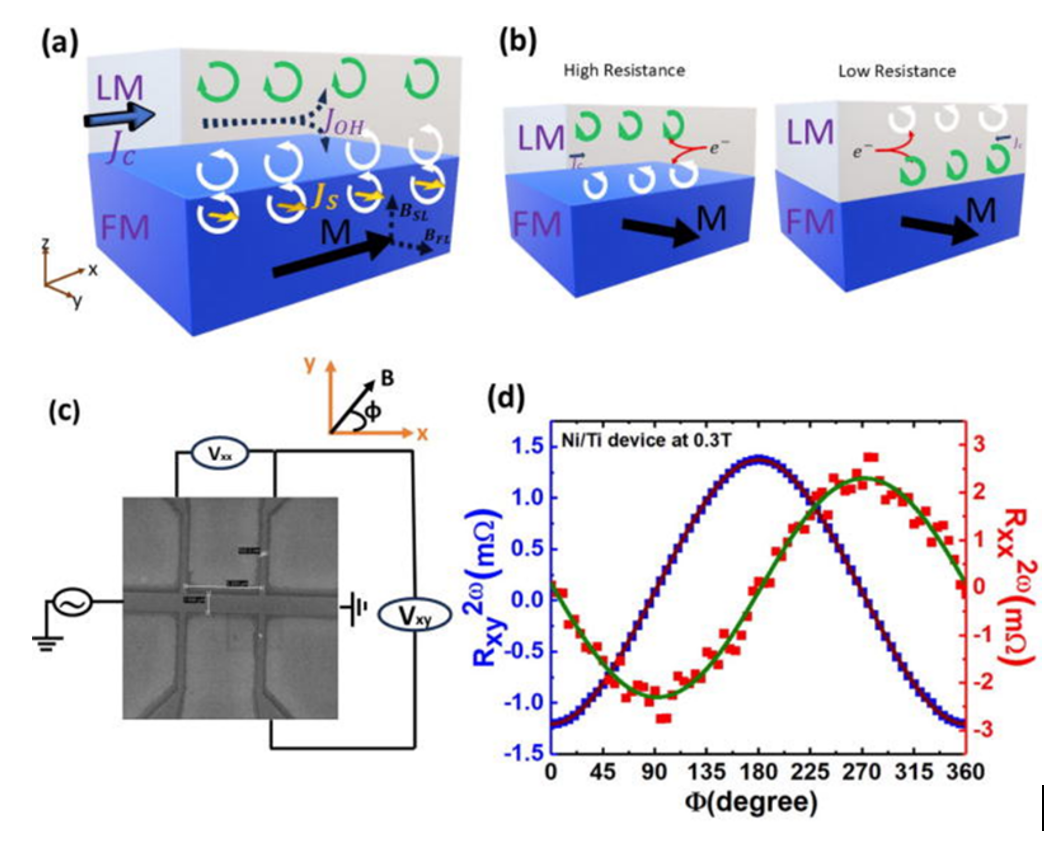
SPINTRONICS LAB: Evidence of orbital Hall current-induced correlation in second-harmonic response of longitudinal and transverse voltage in light metal–ferromagnet bilayers
#Research Highlight
Posted on: July 16th, 2025

Ultrafast and Terahertz spectroscopy (UFTS) group led by Dr. N. Kamaraju
In this work, we have taken a novel and unexplored route of using picosecond strain pulses towards understanding the phenomenon of magnetic dimensional crossover (MDC) in a two-dimensional (2D) van der Waals Heisenberg ferromagnet CrSiTe3 using femtosecond time resolved experiments for the first time to the best of our knowledge. Unravelling the transition from short-range 2D intraplanar magnetic ordering (SRMO) to long-range 3D interplane magnetic ordering in two-dimensional van der Waals materials carries significant potential for both fundamental scientific exploration and technological innovation. However, direct observation of the intricate stages of this magnetic dimensional crossover (MDC) remains a significant experimental challenge. Employing the magneto-elastic coupling for this offers a promising approach, but detecting the subtle lattice response to short-range magnetic order (SRMO) remains challenging. While recent studies using second harmonic generation have hinted at a two-step MDC process, a definitive timeresolved observation has proven elusive. We adopt a novel methodology, utilizing picosecond acoustic strain pulses induced by femtosecond lasers in CrSiTe3, to scrutinize the microscopic mechanisms underpinning MDC in the time domain. This groundbreaking technique enables us to witness firsthand the nuanced yet pivotal impact of spin fluctuations and ordering on the lattice, thereby unveiling the progression of magnetic order with unparalleled precision. Our examination of the temporal and spectral responses of the strain pulse across a diverse temperature range provides a comprehensive depiction of the MDC process. Our investigation further suggests that the generation of strain is influenced not only by the thermoelastic and deformation potential origins, but also by the magnetic strain inherent in the ferromagnetic phase. Consequently, we not only discern a distinct signature of the multi-stage MDC pathway but also uncover hitherto unobserved facets of the interaction between spin dynamics and lattice vibrations. The renormalization in the strain spectrum within the frequency domain, along with the phase change in the time domain, is encapsulated in a phenomenological theoretical model of the spin-lattice interaction, which we have delineated in the manuscript. Furthermore, the ultrafast carrier dynamics that contribute to the electronic multi-exponential background also exhibit signatures of MDC. These discoveries not only facilitate a more profound comprehension of magnetic ordering in layered 3D materials, but also herald a new era of time-resolved experiments with the potential to revolutionize our understanding of spin-based phenomena. We believe the techniques and findings presented in this study could be used as a basis for further research into 2D van der Waals materials and their magnetic properties in designing a new generation of spin-based optoelectronic devices.<\p>
Research Highlights from Ultrafast and Terahertz spectroscopy (UFTS) group led by Dr. N. Kamaraju in collaboration with Prof. Thiruppathaiah Setti’s group from SNBNCBS Kolkata (Single crystals), Prof. Shreeganesh Prabhu’s group in TIFR Mumbai, and Prof. Sidhartha Lal’s group in Department of Physical Sciences, IISER Kolkata.
Authors: Anjan Kumar N M (Anjan NM), Soumya Mukherjee (Soumya Mukherjee), Abhirup Mukherjee, Ajinkya Punjal, Shubham Purwar(Shubham Purwar), Thirupathaiah Setti, Shriganesh Prabhu S(Shriganesh Prabhu), Siddhartha Lal, N. Kamaraju (Kamaraju Natarajan). Congratulations to all the authors, especailly Anjan NM as this work is part of his this PhD thesis.
Credits: High quality single crystals were provided by Prof. Thirupathaiah Setti’s group from SNBNCBS Kolkata (https://people.bose.res.in/faculty/fac_new/setti.html), the experiments were done in my group at DPS, IISER Kolkata and also in Prof. Shriganesh Prabhu’s group in TIFR (https:// sites.google.com/.../thzf.../people/prof-shriganesh-Shriganesh Prabhu), Mumbai. The phenomenological theory was provided by Prof. Siddhartha Lal’s group in DPS, IISER Kolkata (https://epqm.github.io/).
#Research Highlight
Posted on: July 14th, 2025
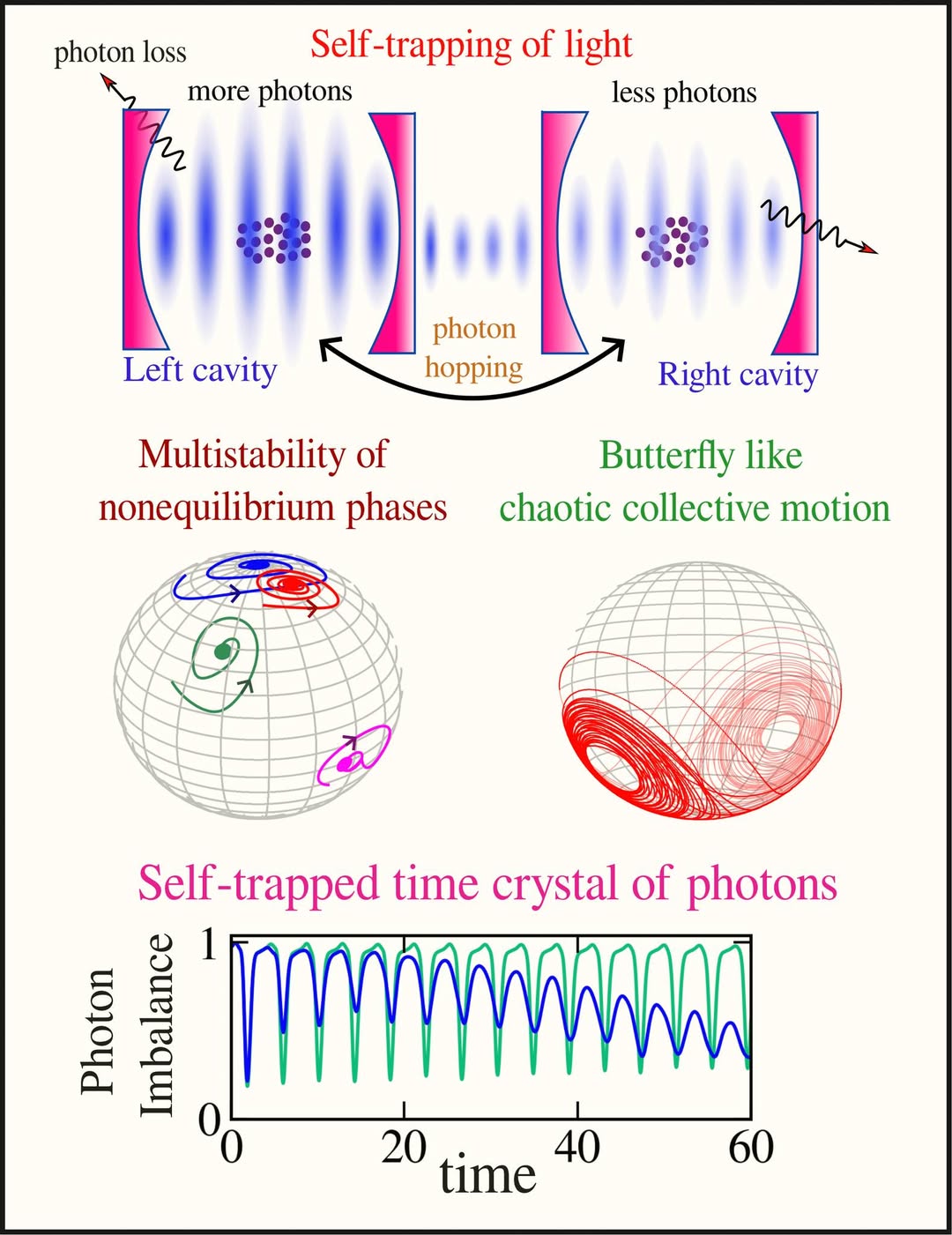
Subhasis Sinha's Group: Self-Trapping Phenomenon, Multistability and Chaos in Open Anisotropic Dicke Dimer
𝗥𝗲𝗳𝗲𝗿𝗲𝗻𝗰𝗲𝘀:
Title: “Self-Trapping Phenomenon, Multistability and Chaos in Open Anisotropic Dicke Dimer”
Authors: G. Vivek, Debabrata Mondal, Subhadeep Chakraborty and S. Sinha
Journal: Phys. Rev. Lett. 𝟭𝟯𝟰, 113404 (2025).
#Research Highlight
#News
Posted on: March 27th, 2025
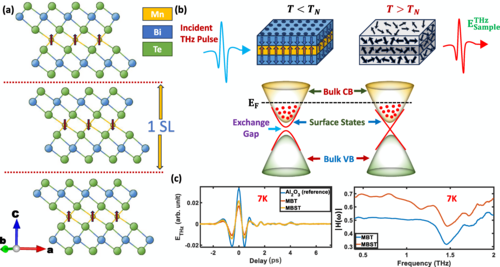
Investigation of magnetic order influenced phonon and electron dynamics in MnBi 2 Te 4 and Sb doped MnBi 2 Te 4 through terahertz time-domain spectroscopy
Authors: Soumya Mukherjee, Anjan Kumar NM, Subhadip Manna, Sambhu G Nath, Radha Krishna Gopal, Chiranjib Mitra, N. Kamaraju
PRB Link: Click here
The interplay of magnetism and topological properties can provide a unique platform for realization of several novel quantum phenomena such as quantum anomalous Hall effect and axion insulator phases. Conventional methods of introducing magnetic order in topological materials like magnetic impurity doping, and magnetic proximity effects provide limited accessibility due to their very low operating temperature (sub kelvin regime) of investigation. With the recent introduction of the first stoichiometric anti-ferromagnetic (AFM) topological insulator (TI) MnBi 2 Te 4 , which hosts inherent magnetic ordering, the mentioned challenges have been repressed to a significant extent. Along with the non-trivial topological properties, MnBi 2 Te 4 provides an avenue to open an exchange gap in TSS due to magnetic ordering induced time reversal symmetry breaking below temperature of ~25 K. However, the nature and the occurrence of the exchange gap, are found to be highly sample specific and have invited contrasting views based on ARPES measurements and IR spectroscopic techniques. As the appearance of the exchange gap mostly influences the low energy (few to tens of meV) spectroscopic responses of MnBi 2 Te 4 , THz-TDS technique becomes instrumental for their in-depth characterizations. Moreover, the observation of IR active E u phonon mode (~1.5 THz, predicated in lattice dynamical calculations of MnBi 2 Te 4 ) and realization of its potential coupling with continuum of surface electron excitations are achievable through THz-TDS measurements.
Here, we have carried out time domain terahertz (THz) Spectroscopy measurements on PLD (pulsed laser deposition) grown epitaxial thin films of MnBi 2 Te 4 (MBT) and Sb doped MnBi 2 Te 4 (MBST) in a temperature range of 7K to 250K. We find that the extracted THz conductivity displays a strong Eu phonon absorption peak (at ∼1.5 THz) merged on top of the Drude like background contribution of bulk and surface electrons for both samples. The extracted parameters from the THz conductivity data fitted to the Drude-Fano-Lorentz model, show significant changes in their temperature dependence around the magnetic ordering Neel temperature of ∼ 25K, which is suggestive of the coupling between magnetic ordering and electronic band structure. The frequency of the Eu phonon displays an anomalous blue-shift with increasing temperatures by ∼ 0.1 THz (∼7%) for MnBi2Te4 and ∼0.2 THz (∼13%) for Sb doped MnBi2Te4. The line-shape of the Eu phonon mode in Sb doped MnBi2Te4 shows significant Fano asymmetry compared to that of MnBi2Te4, indicating that Sb doping plays an important role in the Fano interference between the bulk phonons and the surface electrons, here. A positive value of cubic anharmonicity induced phonon self-energy parameter is attributed to the anomalous blue shift of the Eu phonon mode in MnBi 2 Te 4 . Whereas the relatively higher anomalous shift in the phonon frequency of Sb doped MnBi2Te4 indicates the combined contribution of phonon anharmonicity and electron-phonon coupling, which is consistent with the emergence of Fano asymmetry in it. Our studies suggest THz-TDS is an efficient non-contact technique for probing the behaviour of charge carriers, phonons and their coupling in magnetic TIs. Furthermore, modulation of Fano asymmetry via doping and as a function of temperature has also been realized here. Thus, our investigations pave the way for fabricating a new class of quantum devices using MnBi 2 Te 4 , where both tunable Fano resonance and magnetic order influenced topological properties can be utilized.
#Research Highlight
Posted on: November 2nd, 2024
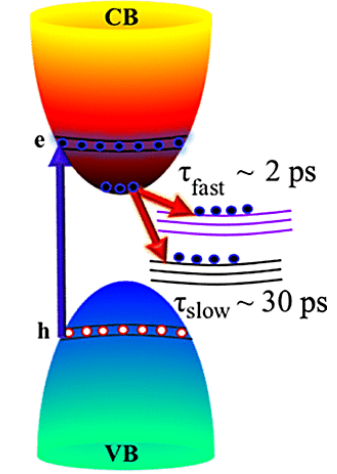
Probing Shallow and Deep Oxygen Traps in Binary Transition Metal Oxide, CoV2O6, Using Ultrafast Pump Probe Spectroscopy
Authors: Anjan Kumar N M, Soumya Mukherjee, Souvick Chakraborty, Ayan Mondal, Debabrata Samanta, Goutam Dev Mukherjee, Venkataramanan Mahalingam, Satyabrata Raj, N. Kamaraju.
Journal: The Journal of Physical Chemistry C (https://pubs.acs.org/doi/epdf/10.1021/acs.jpcc.4c02975)
Transition metal oxides, while promising for optoelectronics, often suffer from performance limitations due to carrier trapping defects. Understanding and mitigating these traps is crucial for enhancing device efficiency.
This study focuses on CoV2O6, a transition metal oxide with unique optical and magnetic properties. Using femtosecond pump-probe spectroscopy, we investigated the ultrafast optical dynamics of CoV2O6 microparticles. Our analysis revealed two distinct types of traps: shallow band-edge states and deeper mid-gap states. These traps were identified through steady-state absorption and photoluminescence measurements, supported by first-principles DFT calculations.
Kinetic modelling of the transient absorption data further confirmed the existence of these traps and their role in capturing photoexcited carriers. We found that shallow traps capture carriers within approximately 2 picoseconds, while deep traps capture them within 30 picoseconds. Our model predicts that approximately 44 % of photoexcited carriers are trapped in shallow traps, and 40 % in deep traps.
This research provides valuable insights into the carrier dynamics and trapping mechanisms in CoV2O6, paving the way for strategies to improve its optoelectronic performance.
The article is now online: https://pubs.acs.org/doi/epdf/10.1021/acs.jpcc.4c02975
#News
Posted on: September 2nd, 2024
𝗣𝗮𝘁𝘁𝗲𝗿𝗻𝗶𝗻𝗴 𝗽𝗿𝗼𝘁𝗲𝗶𝗻𝘀 𝘄𝗶𝘁𝗵 𝗹𝗮𝘀𝗲𝗿-𝗴𝗿𝗼𝘄𝗻 𝗺𝗶𝗰𝗿𝗼-𝗯𝘂𝗯𝗯𝗹𝗲𝘀: 𝗮 𝗽𝗼𝘀𝘀𝗶𝗯𝗹𝗲 𝗻𝗲𝘄 𝗿𝗼𝘂𝘁𝗲 𝘁𝗼𝘄𝗮𝗿𝗱𝘀 𝗹𝗼𝘄-𝗰𝗼𝘀𝘁 𝗱𝗶𝗮𝗴𝗻𝗼𝘀𝘁𝗶𝗰𝘀 𝗮𝗻𝗱 𝗯𝗶𝗼𝘀𝗲𝗻𝘀𝗶𝗻𝗴
Patterning biomolecules (including proteins such as antigens and antibodies) in pre-designed, parallel architectures can be a game-changer in rapid, inexpensive diagnostics. However, typical patterning methodologies, including top-down approaches such as photolithography and e-beam lithography, or bottom-up approaches such as solgel nanofabrication, molecular self-assembly, and DNA-scaffolding - all have limitations in efficacy for various reasons ranging from damaging the biospecimens to being slow and inflexible.
In this context, Microbubble lithography (MBL) is a comparatively recent (about a decade-old) micro-patterning method that uses laser-generated and translated microbubbles to self-assemble and pattern materials of choice in real time. Thus, MBL has been used to pattern diverse mesoscopic organic and inorganic materials, allowing for various applications including the fabrication of plastic electronics, catalytic chips, and even biosensing. However, in spite of its success in patterning mesoscopic entities, MBL has not yet been employed in developing continuous patterns of living organisms. This is primarily due to the high temperatures associated with a bubble nucleated due to heat generated by tightly focusing a laser – which is at the heart of this technique.
In this paper, we report the successful creation of a strategy for immobilizing diverse biospecimens on transparent substrates using MBL. Thus, we develop a heterostructured platform made up of a scaffold to form microbubbles, a crosslinker to facilitate adherence, and finally the concerned immobilized biospecimen. Our deployment of fast laser translation speeds ensures no temperature-induced damage to the biospecimens since their contact time with the microbubbles is less than a hundred milliseconds. Our patterned biospecimens cover a wide range of biological macromolecules, such as reporter proteins, bacterial samples, and viruses at varying concentrations. Most importantly, we also performed experiments to determine the activity of the biospecimens, especially bacterial species and virus strains, post patterning – and obtained conclusive evidence of them retaining their vegetative activity.
Overall, this study sets the groundwork for manufacturing multilayer heterostructures of living matter using MBL, and may open a new paradigm in designing bioelectronic chips, and in fast, inexpensive, and even parallelized biosensing and diagnostics of pathogens, leveraging and highlighting the ubiquitous nature of MBL in terms of patterning ‘everything mesoscopic’.
Article details:
Title: Biologically Active Micropatterns of Biomolecules and Living Matter Using Microbubble Lithography
Authors: Anand Dev Ranjan, Sucharita Bhowmick, Arnab Gupta, Amirul Islam Mallick, Ayan Banerjee
#Research Highlight
Posted on: July 12th, 2024

𝗘𝗺𝗲𝗿𝗴𝗲𝗻𝗰𝗲 𝗼𝗳 𝗾𝘂𝗮𝗻𝘁𝘂𝗺 𝘄𝗼𝗿𝗺𝗵𝗼𝗹𝗲 𝗴𝗲𝗼𝗺𝗲𝘁𝗿𝘆 𝗮𝗰𝗿𝗼𝘀𝘀 𝗮 𝗙𝗲𝗿𝗺𝗶 𝘀𝘂𝗿𝗳𝗮𝗰𝗲 𝗴𝗮𝗽𝗽𝗶𝗻𝗴 𝘁𝗿𝗮𝗻𝘀𝗶𝘁𝗶𝗼𝗻: 𝗨𝘀𝗶𝗻𝗴 𝘁𝗵𝗲 𝗵𝗼𝗹𝗼𝗴𝗿𝗮𝗽𝗵𝗶𝗰 𝗽𝗿𝗶𝗻𝗰𝗶𝗽𝗹𝗲 𝘁𝗼 𝘁𝗿𝗮𝗰𝗸 𝗰𝗵𝗮𝗻𝗴𝗲𝘀 𝗶𝗻 𝗺𝗮𝗻𝘆-𝗽𝗮𝗿𝘁𝗶𝗰𝗹𝗲 𝗲𝗻𝘁𝗮𝗻𝗴𝗹𝗲𝗺𝗲𝗻𝘁
Reference: Holographic entanglement renormalization for fermionic quantum matter. J. Phys. A: Math. Theor. 57, 275401 (2024), DOI: 10.1088/1751-8121/ad56e1
Authors: Abhirup Mukherjee, Siddhartha Patra and Siddhartha Lal
URL: https://t.ly/MaqVk
Juan Maldacena's version of the holographic principle posits a duality relation between a quantum field theory in d-spatial dimensions and a gravity theory in d+1-spatial dimensions. The additional dimension can be visualised as the geometrization of the scaling of various parameters, as well as the many-particle entanglement within, the (almost) critical field theory placed on a "boundary" and which extends into the bulk. This is also known as the AdS/CFT (or gauge-gravity) correspondence, and has been applied mostly as a conjecture reliant on a dictionary between two very different theories. However, employing the conjecture as a computational tool is not without its difficulties. As put forward eloquently by Andrew Green [1],
Indeed, the situation is even more delicate, since at present we cannot deduce the gravitational dual corresponding to any particular microscopic condensed matter Hamiltonian. ... Even accepting the power of this approach, there are good reasons to attempt to construct the gravitational dual to a given condensed matter system directly. Not least amongst these is the determined independence of condensed matter physicists. It rests rather uncomfortably to take anything upon the authority of mathematical tools with which one is unfamiliar. This is a tricky task. In constructing such a dual theory, we must, in a sense, solve precisely the problems that we in the condensed matter community have been struggling with.
In a work that has appeared online just recently, Abhirup Mukherjee, Siddhartha Patra, and Siddhartha Lal have provided an explicit analytic demonstration of the holographic principle by studying a simple and tractable problem: a free fermion system with and without a mass gap (where the gap is an outcome of electronic correlations). The authors employ quantum information measures (such as entanglement entropy and multipartite information) to reveal hierarchical structure within the nature of entanglement possessed by the system. Further, they relate geometric parameters like distance and curvature of the holographic dimension to a renormalization group (RG) beta function of the mass gap, providing thereby an explicit analytic manifestation of the holographic principle.
Their work suggests that the conjectured principle is likely very useful in understanding the properties (e.g., quantum phase transitions) of systems of interacting fermions. Indeed, these transitions appear in the form of wormholes in the associated extra spatial dimension (see figure). More precisely, this wormhole is characterised by a change in the boundedness of the spatial dimension (i.e., its curvature) and corresponds to a change in a topological quantum number of the ground state of the many-electron system (i.e., the Luttinger volume). The additional (conformal) symmetry at the quantum phase transition links the emergent metric and the stress-energy tensor. Finally, in the presence of a strong transverse magnetic field, the Luttinger volume in the metallic state is found to transform into the Chern number of the insulating integer quantum Hall state.
References
[1]: An introduction to gauge-gravity duality and its application in condensed matter. A.G. Green. Contemporary Physics, 54:1, 33–48 (2013).
#Research Highlight
Posted on: July 12th, 2024
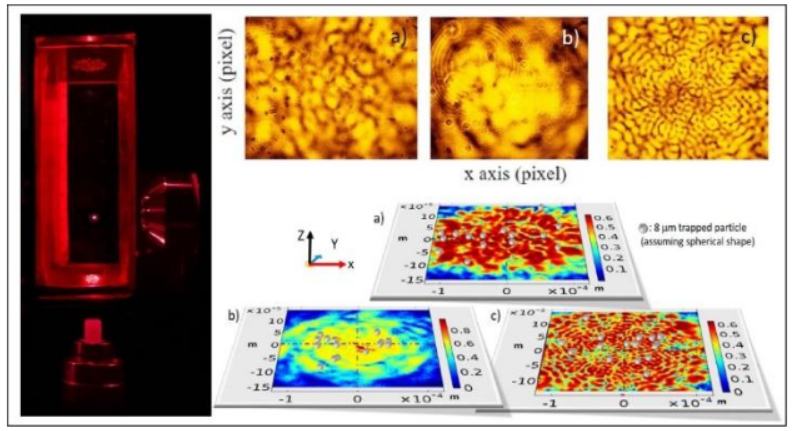
Ultra stable three-dimensional Photophoretic trap in air facilitated by single Multimode fiber.
Research Highlight: Light-Matter Lab
Title: Ultra stable three-dimensional Photophoretic trap in air facilitated by single Multimode fiber.
Authors: Souvik Sil, Anita Pahi, Aman Anil Punse, and Ayan Banerjee
We show that a multimode fiber with its speckle pattern (three figures in the top center) leads to ultrastable photophoretic traps – an intriguing result since such fibers are generally considered unusable for optical trapping. A single particle (observed as a fluorescent spot in the experimental sample chamber) can be trapped stably for hours as shown in the picture on the left. Particles are trapped in various locations of the speckles as shown in the bottom three pictures. Our data also suggest that other than the radial, an axial restoring force too acts on trapped particles – demanding new research on photophoretic forces.
#Research Highlight
Posted on: January 8th, 2024

Observing the individual effects of the electric and magnetic fields of light from the transverse spin of single optically trapped birefringent particles
This work discerns, for the first time, the effects of the electric and magnetic fields of light separately, by their work done on single highly birefringent particles that are optically trapped using vector beams of light.
More elaborately, the work describes an elegant scheme to discern the effects of the electric and magnetic fields of light separately, by their work done on single highly birefringent particles that are optically trapped using vector beams of light. Thus, the authors describe a scheme of generating pure transverse spin angular momentum (TSAM) in their system by tightly focusing radially and azimuthally polarized structured beams with no intrinsic angular momentum into a refractive index stratified medium. The TSAM is then transferred to single highly birefringent particles which spin in a direction parallel to the beam propagation direction. Such choice of beams ensures the breakdown of ‘electromagnetic democracy’ in the context of angular momentum in these systems, which helps demonstrate the action of the electric and magnetic fields on matter, separately.
This work is published in Lasers and Photonics Review with an Impact Factor of 11.
#Research Highlight
Posted on: December 2nd, 2023
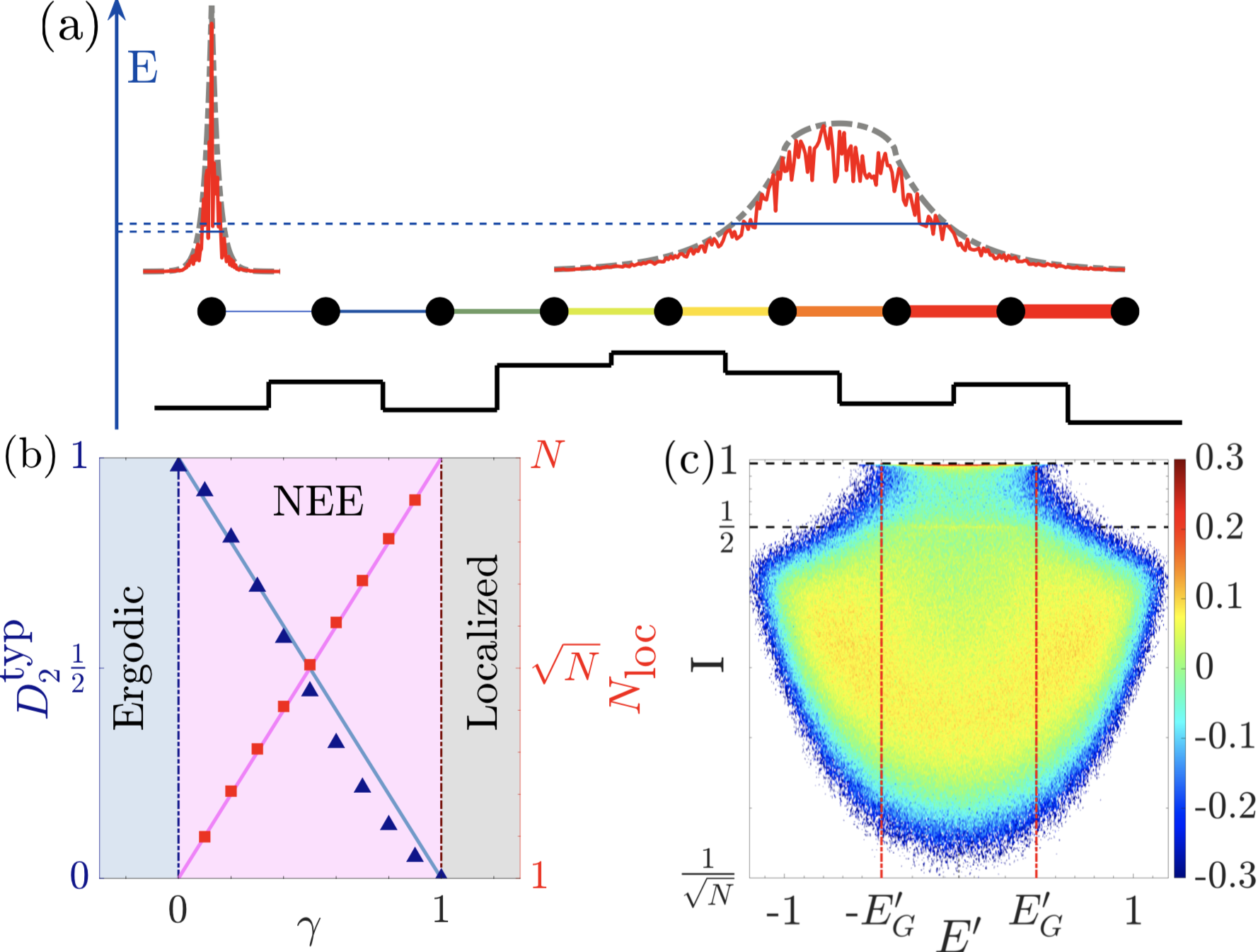
Absence of mobility edge in short-range uncorrelated disordered model: Coexistence of localized and extended states!
In 1967, Sir Nevill F. Mott's pioneering work argued that the extended and the localized eigenstates in a 3-dimensional Anderson model are always separated by a critical energy called the mobility edge. The conventional wisdom has been that this energetic separation is true in any disordered low-dimensional system.
Our work shows that this is not always true in 1-dimensional systems. We identify the necessary criteria for realizing coexistent localized and extended states without forming any mobility edge: residual level repulsion, non-ergodicity of most bulk states, and spatial separation of localization centers. We demonstrate these ideas in a 1D disordered lattice governed by the Hamiltonians from the β-ensemble. We also explain the origin of the anomalous long-range correlations in the energy spectrum of the β-ensemble, which has been a long-standing puzzle in the random matrix theory community.
"Absence of mobility edge in short-range uncorrelated disordered model: Coexistence of localized and extended states"
Adway Kumar Das, Anandamohan Ghosh, Ivan M. Khaymovich Published online 18 October 2023, appeared in 20 October 2023 issue: Physical Review Letters (Vol. 131, No. 16):URL: https://link.aps.org/doi/10.1103/PhysRevLett.131.166401 DOI: 10.1103/PhysRevLett.131.166401
#Research Highlight
Posted on: November 21st, 2023
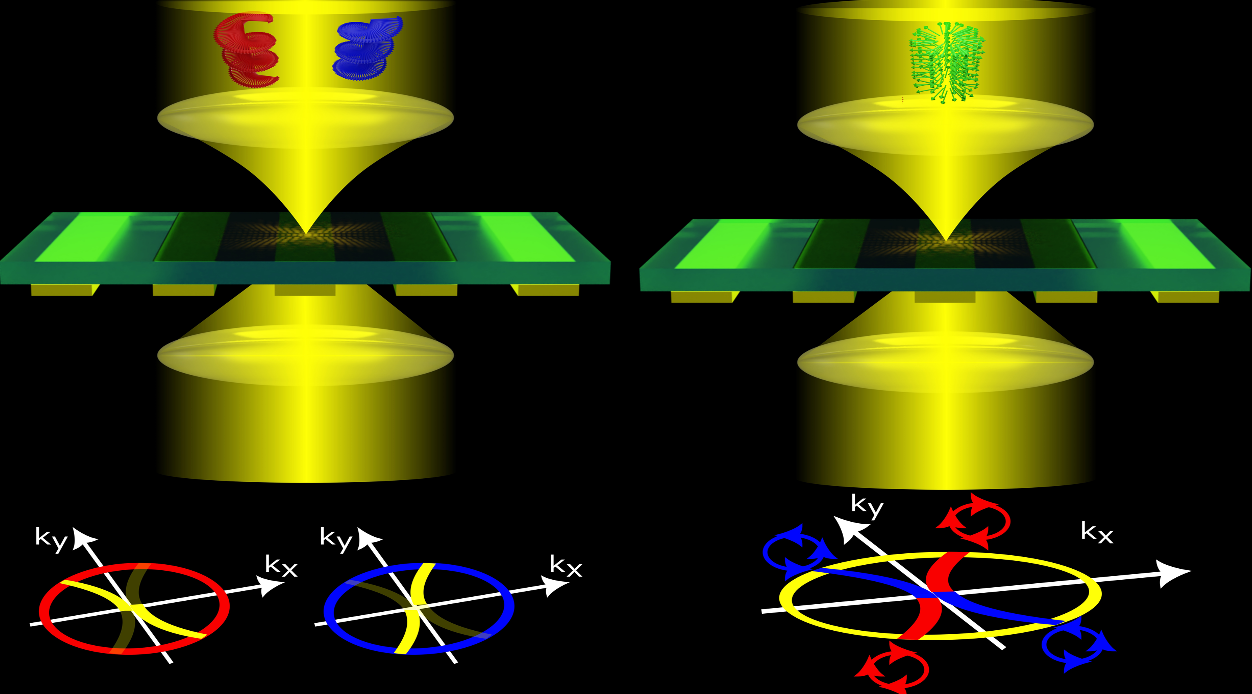
Spin-direction-spin coupling of quasiguided modes in plasmonic metamaterials
Simultaneous demonstration of the forward (left) and inverse (right) spin Hall effect of light in a waveguiding plasmonic crystal
Joint research of bioNap & Light Matter Lab., DPS
“Spin-Direction-Spin Coupling of Quasiguided Modes in Plasmonic Crystals” has been published in Phys. Rev. Lett. 131, 193803 (2023) and featured in the cover page. Jeeban Kumar Nayak, a PhD student of DPS and a former BS-MS student is the primary author of this paper. The other students who were involved in this research are, Shyamal Guchhait (PhD), Harley Suchiang (former BS-MS student), Subir Kumar Ray (former PhD student).
Brief description: The coupling of spin (SAM) and orbital angular momentum (OAM) degrees of freedom of light, the so-called spin orbit interactions (SOI) have led to a number of fundamental photonic effects in various light-matter interactions. These have not only provided new insights on the universal SOI phenomena in classical optical settings but also have opened up novel routes for the development of spin-orbit photonic devices. Among the various SOI effects, photonic spin-momentum locking has attracted particular attention due to its fundamental nature and potential device applications. We have observed an unusual spin-direction-spin coupling phenomena using the leaky quasiguided modes of a waveguided plasmonic crystal system. We have observed simultaneous spin controlled directional guiding of waves (spin-direction coupling) and its reciprocal effect of wavevector-dependent spin acquisition of the scattered light (direction-spin coupling) from the same nanophotonic system, which we have defined as `spin-direction-spin coupling' phenomena. While the former effect manifests as the conventional photonic spin Hall effect (SHE), the latter is known as the inverse SHE of light, which is rather new and has not been explored much. The inverse SHE of light reported in our system can be seen as an optical analogue of the spin-injection in the solid-state spintronic devices; where with unpolarized excitation (no input SAM), the scattered light acquires a particular spin polarization according to the scattering direction. These SOI effects are shown to be mediated by the evolution of space-varying polarization due to highly non-paraxial focused light and its subsequent interaction with the polarization-anisotropic quasiguided modes of the plasmonic crystal system.
The fundamental origin and the unconventional manifestation of the spin-direction-spin coupling phenomena from a relatively simple system, ability to probe and interpret the resulting phenomena in the far field through momentum-domain polarization analysis, and their regulated control in plasmonic-photonic crystals open exciting avenues in spin-orbit photonic research.
Link to the paper: https://journals.aps.org/prl/issues/131/19.
#Research Highlight
Posted on: November 13th, 2023
Trapping and exciton-exciton annihilation assisted ultrafast carrier dynamics in nanosheets of 2H-MoSe2and Cr doped 1T/2H-MoSe2
Research Highlights from Ultrafast and Terahertz spectroscopy (UFTS) group led by Dr. Kamaraju
Transition metal dichalcogenides (TMDC) in monolayer or few-layers form have attracted significant interest due to their intriguing physical properties, such as layer-dependent band structure, high exciton binding energy, valley selective optical excitation and applications like electrocatalysis, photocatalysis, optoelectronics. The preparation of TMDCs via colloidal synthesis method has been drawing considerable attention recently due to their extremely low-cost fabrication, efficient control over size and shape, and easy implementation in device fabrication via methods such as drop-casting, and spray-coating. Despite several advantages, unintentionally formed defect states in these colloidally synthesized TMDCs are crucial in device- performance and need proper characterization for efficient device formation.
In this work we have employed ultrafast time-resolved non degenerate pump–probe spectroscopy to explore the role of defects in carrier dynamics of colloidally synthesized few-layer single-phase 2H-MoSe2 and mixed-phase 1T/2H-MoSe2 nanosheets. Metastable metallic 1T-phase has been introduced via Cr doping to coexist with stable 2H-phase to form stable mixed-phase 1T/2H-MoSe2 nanosheets which has been selected for pump-probe studies to reveal the physical processes governing its enhanced photocatalytic activities compared to 2H-MoSe2. After above bandgap excitation and probing at A-exciton peak, the differential probe transmission data for both the samples show photo-induced bleaching at earlier pump-probe delay followed by photo-induced absorption unveiling signatures of exciton-state filling, exciton trapping, defect-mediated photo-induced probe absorption and recombination of defect bound excitons. Pump-fluence dependent reduction of decay time constants of bound-exciton-recombination and further modelling of exciton population using higher order kinetic rate equation reveals that the two-body exciton-exciton annihilation governs the exciton recombination process initially with a decay rate of ∼10−8 cm3 s −1. Our analysis also suggests that the fraction of total excitons that decay via long decay channel decreases with increasing exciton density for 2H–MoSe2, in contrast to 1T/2H–MoSe2 where the fraction of excitons decaying via long decay channel remains constant, consistent with its higher photocatalytic efficiency. This work estimating crucial parameters such as trapping time, exciton-exciton annihilation rate, and shares of many-body and single-body processes in the exciton-decay should be instrumental in optimizing properties of colloidally synthesized mixed-phase MoSe2 nanosheets for applications like optoelectronics and photocatalysis.
#Research Highlight
Posted on: November 3rd, 2023

Lattice anharmonicity and incomplete soft mode
#Research Highlight
Posted on: August 21st, 2023
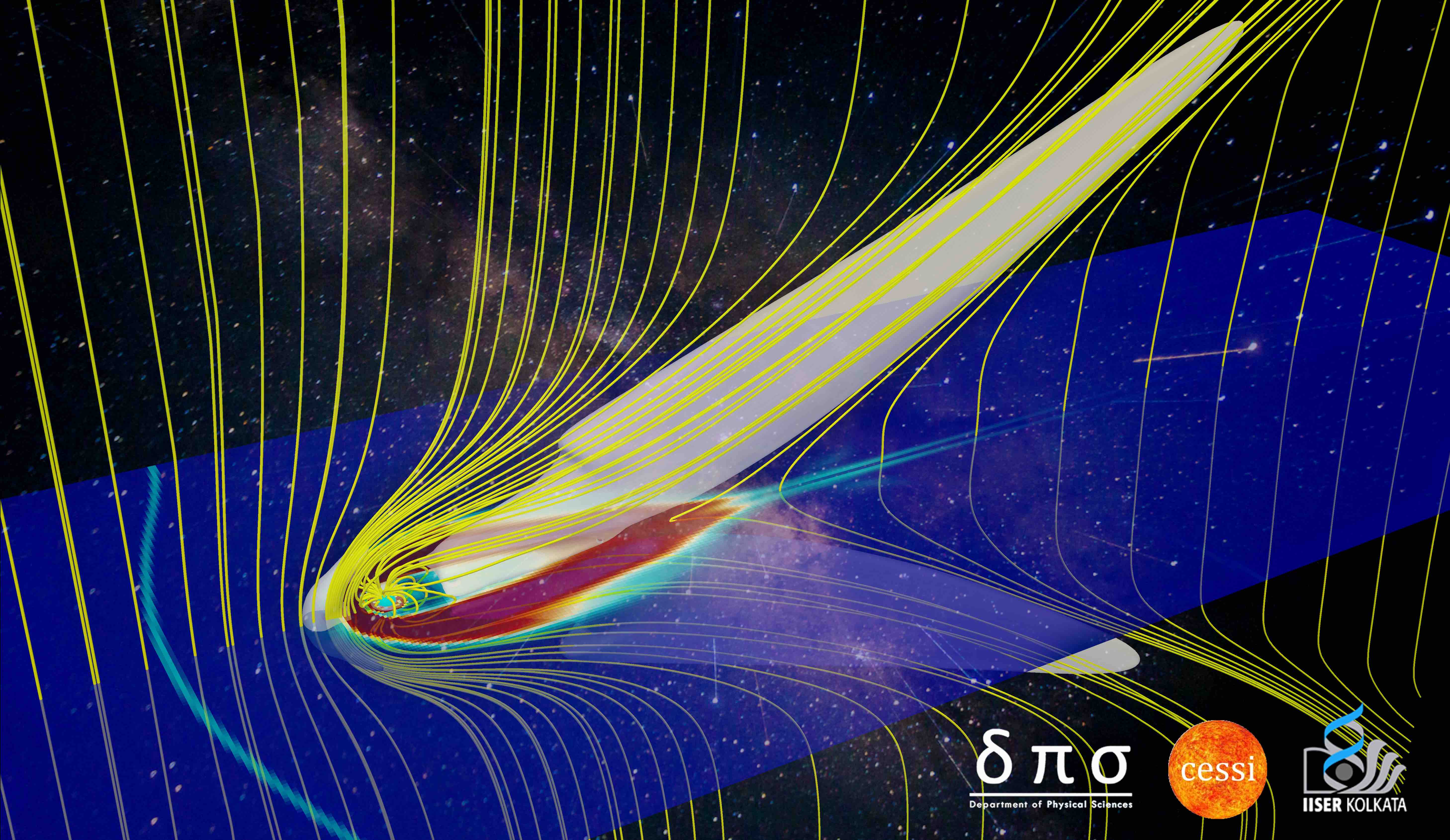
A Surprising Link between Cosmic Magnetism and Life
Exploration of planets in our own solar system and the discovery of more than 5000 exoplanets has the scientific community excited about the possibility of life beyond Earth. The possibility of life and the ultimate fate of planets such as the Earth are influenced by diverse factors including the nature of the stars they orbit. The strength of the invisible magnetic field - known as the magnetosphere - that surrounds a planet, as well as the strength of the magnetic field of its host star, which for us, is the Sun, have a surprisingly important role on this context, a new study from Department of Physical Sciences and the Center of Excellence in Space Sciences India finds.
In the study published in the Astrophysical Journal, PhD student Sakshi Gupta, Research Scientist Arnab Basak and Prof. Dibyendu Nandi present computer simulations exploring the interplay of cosmic magnetic fields that can result in the loss of a planet's atmospheres and their ability to host life. They go on to establish a mathematical equation which relates atmospheric mass loss rate to the relative strengths of stellar and planetary magnetic fields. Their findings are expected to aid in the identification of habitable star-exoplanet systems and catalyse observational efforts for measuring exoplanetary magnetic fields.
Reference: Gupta, S., Basak, A. and Nandy, D. 2023, “Impact of Changing Stellar and Planetary Magnetic Fields on (Exo)planetary Environments and Atmospheric Mass Loss”, Astrophysical Journal, Volume 953, Page 70
Journal: https://iopscience.iop.org/article/10.3847/1538-4357/acd93b
Arxiv: https://arxiv.org/abs/2303.04770
#Research Highlight
Posted on: August 5th, 2023
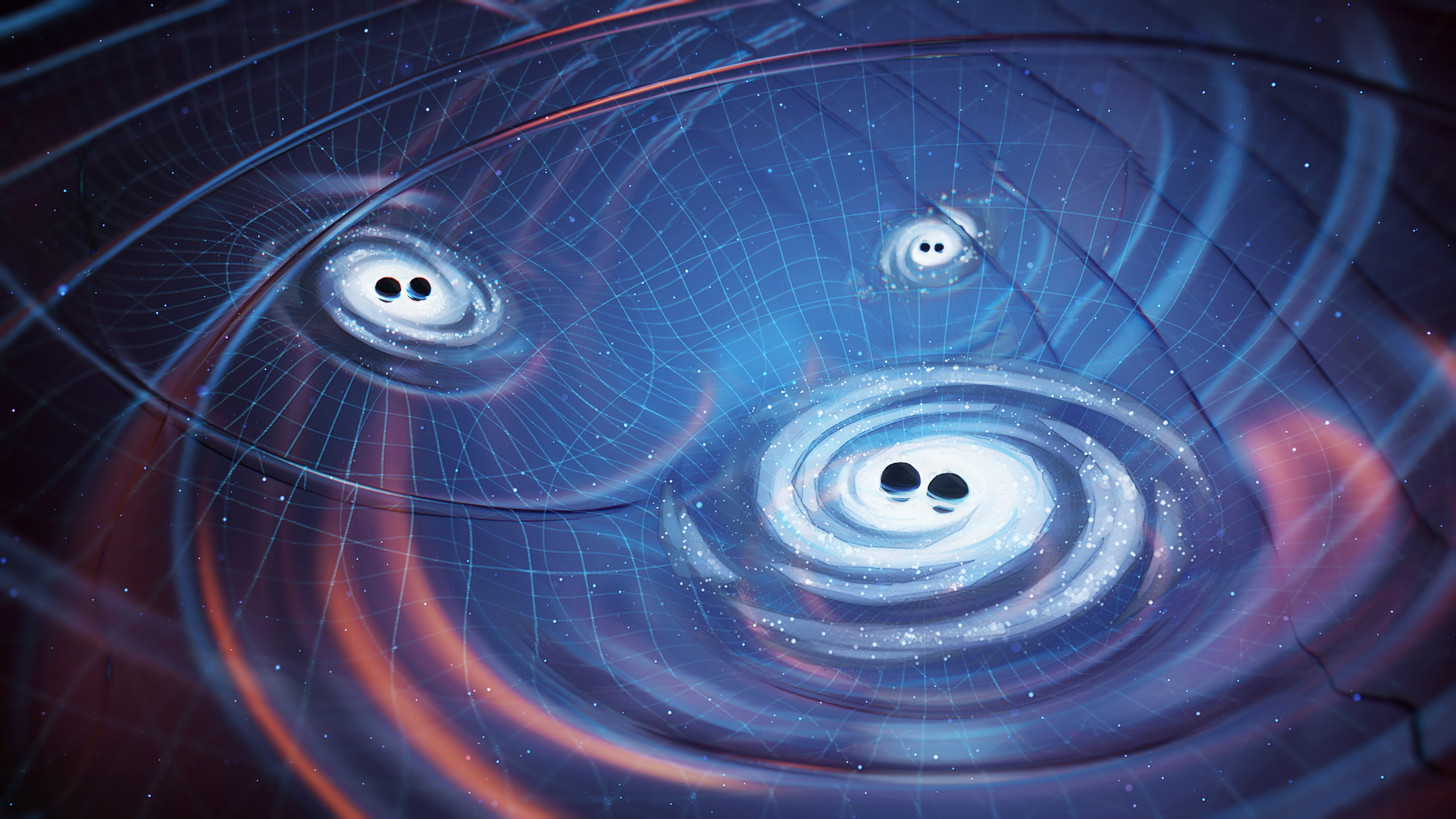
Radio telescopes detected the gravitational waves hum by studying pulsars
On June 29, an international group of scientists recorded the hum of the gravitational waves of the universe using six of the world’s most sensitive radio telescopes, including India’s Giant Metrewave Radio Telescope (GMRT), located near Narayangaon, Pune.
Gravitational waves were proposed by Albert Einstein in 1916 but were first detected by Laser Interferometer Gravitational-Wave Observatory (LIGO) in 2015.
Radio telescopes detected the gravitational hum by studying pulsars, a type of rapidly rotating neutron stars, which form when a massive star runs out of fuel and collapses. A pulsar acts as a cosmic lighthouse, which emits radio beams that hit Earth.
Gravitational waves are thought to change the arrival times of these radio flashes, allowing researchers to document the hum.
Fazal Kareem a Final year BS-MS Student at IISER Kolkata was involved in the discovery of the stochastic background gravitational waves, the humming of the universe, along with 40+ other researchers of the Indian Pulsar Timing Array Collaboration. The team reported significant evidence for the presence of GWB in their pulsar timing dataset. Fazal was involved with the observation of pulsars (the most important part of the experiment), data analysis, noise analysis and combination of the European Pulsar Timing Array data with InPTA data.
Figure: Artist's rendering of black hole binaries emitting gravitational waves. As the waves overlap, they produce a background of gravitational waves that creates a distinctive correlation pattern in the timing of pulses coming from pairs of pulsars.
#Research Highlight
Posted on: July 10th, 2023
Many-Body Interaction Governed Ultrafast Relaxation Dynamics of Hot Holes in CuS Nanoflakes and Photocatalytic Efficiency Enhanced CuS/Ag 2 S Nanocomposites
Research Highlights from Ultrafast and Terahertz spectroscopy (UFTS) group led by Dr. Kamaraju Natarajan
Covellite (CuS) is a direct band gap p-type semiconductor with a high intrinsic hole population causing localized surface plasmon resonance (LSPR) in NIR regime. Though these highly dense (~10 21 /cm 3 ) hole populations have immense potential to enhance photocatalytic efficiency, their ultrafast decay after photoexcitation causes a significant drawback. To enhance the photocatalytic efficiency of CuS, the relaxation of hot carriers needs to get delayed, and this can be achieved via transferring these hot carriers to another material with which CuS can stay in a composite formation. CuS/ is one such photocatalytic efficiency-enhanced nanocomposite, as observed in an earlier report. In this work, we have conducted non-degenerate ultrafast pump-probe transmission studies of CuS nanoparticles and CuS/Ag 2 S nanocomposites with varying pump fluence to explore their hot hole relaxation dynamics and determine the underlying physics of photocatalytic efficiency enhancement. The measured transient transmission data for CuS is found to originate from both photoinduced bleaching of intrinsic holes and photoinduced absorption of excited electrons. But, the localization of hot electrons in the conduction band of Ag 2 S is found to cause the disappearance of photoinduced absorption in the transient transmission of CuS/Ag 2 S at all the pump fluences except for the highest one. The first-order relaxation process based multi-exponential (ME) modeling of transient transmission data for CuS reveals three hole decay channels (∼240-410 fs, ∼24-144 ps, ≳10 µs) along with the electron decay channel of ∼1-2.6 ps. Whereas for CuS/Ag 2 S, the electron decay channel disappears, and a new hole decay channel appears making a total of four decay channels for holes (∼230-470 fs, ∼10-49 ps, ≳10 µs, ∼132-326 ps). The decay time constants are found to vary considerably with increasing pump fluence (wide range of pump fluence ranging from 0.04 mJ/cm 2 to 1.22 mJ/cm 2 ), indicating the involvement of higher-order decay processes and suggesting the need of modeling using kinetic rate equation that involves appropriate higher order terms. Extraction of transient hole densities from pump-probe measurement and modeling them using a suitable kinetic rate equation (KRE) model capable of detecting higher-order processes have been performed to reveal the exact involvement. KRE modeling extracts first, second and third order decay rate constants. The first order decay agrees with the long decay time obtained from ME fitting. And the second and third order decay rates for CuS/ get reduced by almost one order compared to CuS, indicating a reduction in overall decay rates for CuS/ consistent with its enhanced photocatalytic activity. These results are found to indicate the presence of fast trapping of hot holes and a three-hole Auger kind of process involving two free holes and one trapped hole. These observations are very much relevant for fabricating efficient light harvesting devices using CuS and its composites.
Cite This: https://doi.org/10.1021/acsaom.3c00153
#Research Highlight
Posted on: July 10th, 2023
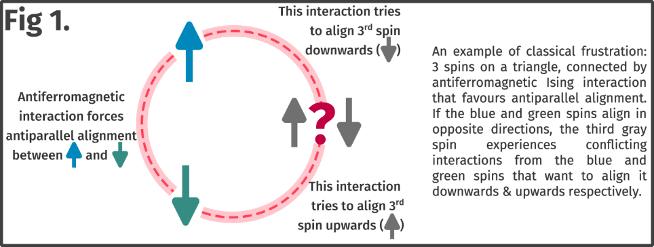
Siddhartha Lal Reserach Group : Frustration shapes multi-channel Kondo physics: a star graph perspective
Frustration. We think we understand it, and how to deal with it. But what does frustration refer to in a quantum system? Consider classical spins (i.e., spins that have only two configurations, say, pointing up and pointing down) placed on an equilateral triangle and interacting with one another through a nearest neighbour antiferromagnetic Ising exchange interaction. It is easy to see that Neel (anti-parallel) ordering is no longer possible: for any two spins that are anti-aligned with one another, the third is left confused on which direction to choose (see Fig.1). This confusion is labelled as the frustration of the classical Neel order. Frustration can also been seen in quantum mechanical systems: while two quantum spin 1/2s with an antiferromagnetic Heisenberg interaction will form a maximally-entangled singlet state, introducing a third spin-1/2 creates a dilemma (see Fig.2) - the two-spin singlet cannot accommodate another spin (often curiously referred to as entanglement monogamy). Since the spin-flip quantum fluctuations of the system will want to lower the energy of the system by entangling all three spins, no spin can be left free and the two-spin singlet cannot be the true ground-state.
The multichannel Kondo problem involves a local antiferromagnetic Heisenberg interaction between a single spin-1/2 impurity and the electrons of several conduction bath channels (see Fig.3). Had there been only one conduction bath, the impurity moment would form a singlet together with a “cloud” of electrons from the bath. We refer to this as the screening of the impurity moment (as the singlet has no magnetisation). However, in the multichannel Kondo problem described above, the formation of a singlet between the impurity and electron from one of the conduction channels is frustrated. As a result, the so-called Kondo screening of the impurity spin’s magnetic moment is hampered. Indeed, if the total spin of the conduction bath is greater than the spin of the impurity, the multichannel Kondo problem is said to be over-screened. The screening process, as well as its breakdown, are truly many-body in nature: a macroscopic number of conduction electrons interact with a single quantum impurity, and are therefore “aware” of one another. A proper description of the physics thus requires a field-theoretic treatment of the impurity-bath interactions, and the problem has been studied using a wide variety of powerful analytic and numerical methods.
Our contribution in this work was to show that the fascinating properties of the N-channel Kondo problem could be linked to those of the associated skeletal problem: a central quantum spin-1/2 coupled to N quantum spin-1/2s (corresponding to the N conduction channels) through identical antiferromagnetic Heisenberg exchange couplings. Such a model is often referred to as a star graph, and it can be identified as a limit of the multichannel problem in which the kinetic energy of the itinerant electrons has been switched off. We show in our work that certain properties of the star graph, such as the ground-state degeneracy and the magnetisation, are linked to bulk thermodynamic properties. The star graph also sets the scattering phase shift of the conduction electrons, and the scattering phase shift then dictates how the quantum fluctuations resolve themselves in order to lead to novel features. In this way, the quantum frustration inherent in the underlying simple quantum mechanical problem is seen to offer great insights into a many-body problem which looks quite daunting otherwise. Please read our work to find out more.
Authors: Siddhartha Patra, Abhirup Mukherjee, Anirban Mukherjee, N. S. Vidhyadhiraja, A. Taraphder, and Siddhartha Lal Journal Reference: Journal of Physics: Condensed Matter 35, 315601 (2023) Link: https://iopscience.iop.org/article/10.1088/1361-648X/acd09c
#Research Highlight
Posted on: May 23rd, 2023
Ultrafast THz Spectroscopy Group: Investigation of conductivity and shielding efficiency of the free-standing PVA-GO-Ag composite thin films in terahertz regime using time domain terahertz spectroscopy
#Research Highlight
Posted on: April 23rd, 2023

Position-position classical entanglement of light from bioNap research group (Prof. Nirmalya Ghosh)
#Research Highlight
Posted on: April 22nd, 2023
Photoexcited Ultrafast Dynamics of Free Carriers and Polarons in V2O5 Microparticles through Time-Resolved Nondegenerate Pump Probe Spectroscopy (Dr. Kamaraju Natarajan )
#Research Highlight
Posted on: April 21st, 2023
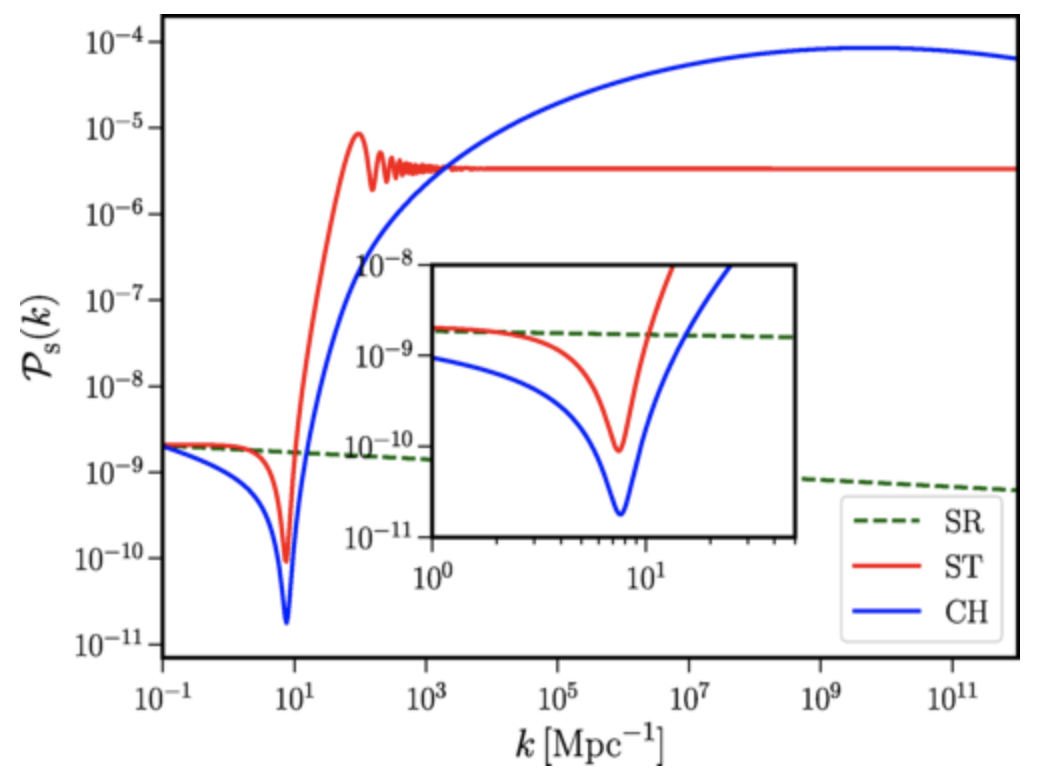
Dr. H. V. Ragavendra publishes in Physical Review Letters: Observing Nulling of Primordial Correlations via the 21-cm Signal
#Research Highlight
#Achievement
Posted on: February 17th, 2023
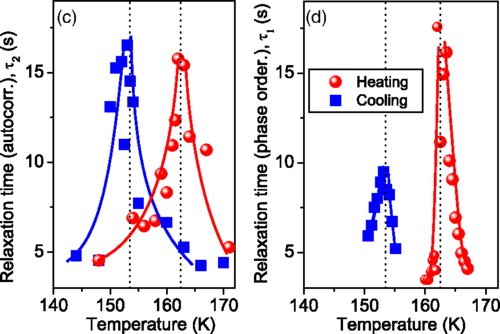
EXPERIMENTAL DEMONSTRATION OF SLOWING DOWN AND ENHANCEMENT OF FLUCTUATIONS IN AN ABRUPT MOTT TRANSITION
#Research Highlight
#Achievement
Posted on: March 16th, 2020

DOES STRETCHING YOUR MUSCLE HELP IN HEALING WOUND? A NEW STEP TOWARDS THE PUZZLE
#Research Highlight
Posted on: June 29th, 2018
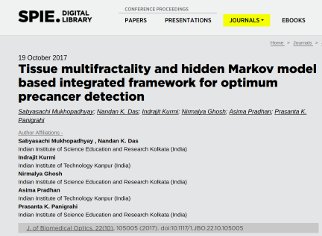
EARLY-STAGE CANCER DETECTION USING HIDDEN MARKOV MODEL BASED INTEGRATED FRAMEWORK
#Research Highlight
Posted on: December 24th, 2017
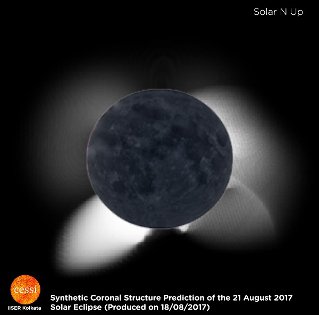
IISER KOLKATA RESEARCHERS PREDICT CORONAL STRUCTURE FOR THE GREAT AMERICAN SOLAR ECCLIPSE
#Research Highlight
Posted on: August 25th, 2017
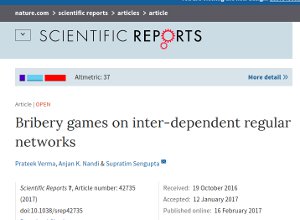
NEW SCIENTIFIC INSIGHTS FOR TAMING BRIBERY IN PUBLIC LIFE
#Research Highlight
Posted on: March 7th, 2017
